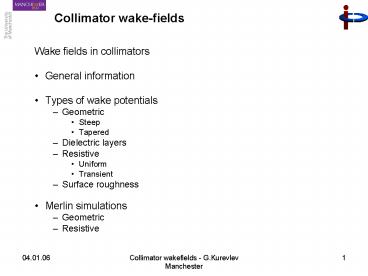Collimator wakefields - PowerPoint PPT Presentation
1 / 12
Title:
Collimator wakefields
Description:
The generated fields will affect any trailing particle following the leading one. ... With higher modes and correction confirmed by MAFIA and Merlin simulations ... – PowerPoint PPT presentation
Number of Views:33
Avg rating:3.0/5.0
Title: Collimator wakefields
1
Collimator wake-fields
- Wake fields in collimators
- General information
- Types of wake potentials
- Geometric
- Steep
- Tapered
- Dielectric layers
- Resistive
- Uniform
- Transient
- Surface roughness
- Merlin simulations
- Geometric
- Resistive
2
General information about Wake fields applicable
to collimators and waveguides
- General theory
- When charged particle is moving through linac or
any other structure in accelerator it generates
fields in the structure. - Reasons of the fields can be different limited
resistivity of the pipes, dielectric layers on
the walls, macro obstacles or micro obstacles due
to surface roughness. - The generated fields will affect any trailing
particle following the leading one. In general
the fields depend on both particles positions so
the momentum change is (Stupakov) - And we can define wakes
- We can integrate over the structure fields
generated by the bunch to get total effect of
fields on particles from the same or the next
bunch. Total effects are usually expressed in
loss and kick factors. Loss factor is the
integrated energy (momentum) loss by the bunch
over passing the structure. Kick factor is
usually average transverse angle gained by the
bunch passing the structure. - Fields of the leading particle are calculated
assuming there are no transverse displacements of
the particle during passing the structure due to
the Wake fields.
3
General information about Wake fields applicable
to collimators and waveguides
- Superposition
- Superposition principle allows us to calculate
one particle fields and then integrate over all
the other particles in the bunch so - We can split bunch of relativistic particles into
transverse slices. - Si slice position in the bunch.
- Wake fields of the slice can be received by
integration over transverse distribution of the
particles in the slice. - Wake fields of the bunch can be received by
convolution over longitudinal distribution of the
particles in the bunch. - Slices cannot mix so we can express all the field
components in a frequency domain in a following
way - In ultrarelativictic limit we have vc
4
General information about Wake fields applicable
to collimators and waveguides
- Uniform structures
- For uniform structures we don't need to integrate
over longitudinal direction of the structure as
the fields don't depend on this so we need only
get the field itself. - Wake fields are estimated over the unit length of
the structure. - Different units of measurements for Wakes used
here (1/L). Consequently to get usual loss or
kick factors we need to multiply by L.
5
Geometric wakefields
- Linked with macro obstacles in the structures
such collimators as a whole. - In steep collimators diffraction theory
applicable so we have - Circular case (Chao)
- With higher modes and correction confirmed by
MAFIA and Merlin simulations - Rectangular case (Stupakov)
- No higher modes yet and for m1
- Tapered cases
- Circular (Yakoya)
- Rectangular (Stupakov)
6
Dielectric wakefields
- Investigated as new collective acceleration
methods (Park, Hirshfield (2000)) - Usual approach is similar to resistive wakes -
field matching technique on boundaries - The difference is that we dont need to count
energy loss in the walls but have waves with
different speed in different media. - Cn-normalization constant that can be received by
orthonormality relation and from the source
currents.
7
Resistive wakefields
- Linked with finite conductivity of the metal
walls of the pipe. - Analysis usually limited by uniform structures
- Circular case well investigated
- Chao
- Bane, Sands with corrections for small s and
for a.c. conductivity - Flat and elliptic cases (Piwinski Yokoya)
- Rectangular case and elliptic case (Gluckstern)
only monopole and dipole - Form factors in comparison with round case
- Transition effects were studied recently for
short bunches and for the same circular case by
Ivanyan, Tsakanov Glukstern Stupakov - It was demonstrated how the potential evolves to
uniform one received in Bane, Sands paper when
there is a transition from infinite to finite
conductivity pipe at some z.
8
Resistive wakefields
- Rectangular case again
- Known approach for rectangular case
perturbation theory (Gluckstern Palumbo). - Following Chaos analysis but in Cartesian
coordinates we can get similar expression for all
the fields. Ignoring space charge in
ultrarelativistic limit we will get constant
longitudinal electric field in the pipe.
Integrating this over frequency we will get the
same expression for 0 order longitudinal wake as
in circular case. - 1st order solutions based on Poisson equation and
Leontovich boundary condition. - Form factors received for rectangular case are
quite similar to elliptical - In fact we can utilize standard eigenfunctions
approach developed for dielectric layered
waveguides for rectangular case. Different set of
eigenfunction - so we need to use different
orthonormality relations to get normalization
constant. This is under investigation now.
9
Merlin simulation
- Merlin - optical code with phenomenological wake
fields to get the effect on beam transport
through the linac and BDS - Merlin had a process for handling wake fields. We
inserted Wake functions. - Bunch slices for wakes integration prepared and
integration already implemented - Momentum change on slice i
10
Merlin simulation
- Geometric wake for steep collimator, kick factor
- SLAC experiment Merlin simulation
with up to 50 modes
11
Merlin simulation
- Resistive
- SLAC experiment Merlin simulations
for 5 modes (1-Cu, 2- Ti)
12
Merlin simulation
- Dielectric wakes, in progress































